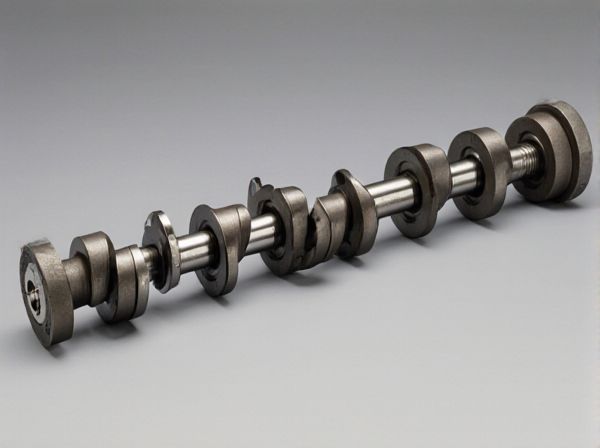
Photo illustration: Forged Crankshaft vs Cast Crankshaft
A forged crankshaft offers superior strength and durability compared to a cast crankshaft, making it ideal for high-performance and heavy-duty engines. Cast crankshafts are typically more cost-effective but may be less resilient under extreme stress or high RPM conditions. Your choice depends on the balance between budget constraints and the required performance level for your engine.
Table of Comparison
| Feature | Forged Crankshaft | Cast Crankshaft |
|---|---|---|
| Material | High-strength forged steel | Molten metal cast iron or steel |
| Durability | Superior tensile strength, high fatigue resistance | Moderate strength, prone to micro-cracks |
| Weight | Lighter due to denser grain structure | Heavier, less dense material |
| Cost | Higher manufacturing cost | Lower manufacturing cost |
| Performance | Better for high-performance and racing engines | Suitable for standard, everyday vehicles |
| Longevity | Longer lifespan under extreme conditions | Shorter lifespan with potential cracking |
Overview of Crankshaft Manufacturing Methods
Forged crankshafts are created by shaping heated steel billets using high-pressure forging processes, resulting in enhanced strength and fatigue resistance due to the grain structure alignment. Cast crankshafts are produced by pouring molten metal into molds, offering cost-effective manufacturing but typically lower tensile strength and durability compared to forged counterparts. The choice between forged and cast crankshafts depends on factors such as engine performance requirements, manufacturing costs, and desired component longevity.
What is a Forged Crankshaft?
A forged crankshaft is manufactured by heating a solid billet of steel and shaping it under immense pressure, resulting in a denser and stronger component compared to cast crankshafts. This manufacturing process enhances the crankshaft's tensile strength, fatigue resistance, and durability, making it ideal for high-performance or heavy-duty engines. Forged crankshafts also exhibit improved resistance to stress fractures and deformities, ensuring reliability under extreme engine loads.
What is a Cast Crankshaft?
A cast crankshaft is manufactured by pouring molten metal into a mold to form the desired shape, typically using cast iron or cast steel, which offers cost-effective production for standard engine applications. This process results in a crankshaft with less tensile strength and fatigue resistance compared to forged crankshafts, making it suitable for moderate power outputs and everyday driving conditions. Cast crankshafts are favored in mass-produced vehicles due to their lower manufacturing expense and adequate durability for non-high-performance engines.
Key Differences Between Forged and Cast Crankshafts
Forged crankshafts are manufactured by compressing a solid billet of steel, resulting in a denser grain structure that offers superior strength, durability, and resistance to fatigue compared to cast crankshafts. Cast crankshafts, produced by pouring molten metal into molds, typically contain more internal porosity and have lower tensile strength, making them suitable for lower-stress applications. The key differences between forged and cast crankshafts lie in material density, mechanical strength, and performance reliability under high-stress conditions.
Strength and Durability Comparison
Forged crankshafts exhibit superior strength due to the metal's grain structure aligning during the forging process, resulting in enhanced fatigue resistance and impact toughness compared to cast crankshafts. Cast crankshafts, made by pouring molten metal into molds, tend to have more porosity and inclusions, which can reduce durability under high-stress conditions. For high-performance or heavy-duty applications, forged crankshafts provide greater reliability and longer lifespan, while cast crankshafts are typically sufficient for standard engine demands.
Performance Implications: Forged vs Cast
Forged crankshafts offer superior strength and durability compared to cast crankshafts due to their dense grain structure, enabling better resistance to fatigue and high stress in high-performance engines. Cast crankshafts, while more cost-effective and suitable for standard applications, are more prone to fatigue failure under extreme loads, limiting their performance potential. The enhanced mechanical properties of forged crankshafts provide improved engine reliability and allow for higher RPMs and increased power output.
Cost Analysis: Forged Crankshaft vs Cast Crankshaft
Forged crankshafts typically have a higher initial cost due to the more complex manufacturing process and superior material strength, making them ideal for high-performance or heavy-duty applications. Cast crankshafts are generally less expensive to produce, offering cost savings for standard passenger vehicles but with lower fatigue resistance and durability under extreme stress. Evaluating total cost of ownership, forged crankshafts may reduce long-term expenses through improved reliability and reduced maintenance, while cast alternatives prioritize upfront budget constraints.
Applications and Usage Scenarios
Forged crankshafts are preferred in high-performance and racing engines due to their superior strength and durability under extreme stress and high RPM conditions. Cast crankshafts are commonly used in standard passenger vehicles and light-duty applications where cost-effectiveness and adequate performance for everyday driving are prioritized. Industrial engines and heavy-duty trucks often utilize forged crankshafts to ensure longevity and resistance to fatigue in demanding operational environments.
Maintenance and Longevity Considerations
Forged crankshafts exhibit superior durability and resistance to fatigue compared to cast crankshafts, resulting in longer service life and reduced maintenance frequency under high-stress conditions. Cast crankshafts, while cost-effective, are more prone to crack formation and wear, necessitating more frequent inspections and potential replacements. Maintenance schedules for forged crankshafts typically allow for extended intervals due to their enhanced structural integrity and ability to withstand extreme loads without deformation.
Choosing the Right Crankshaft for Your Engine
Choosing the right crankshaft for your engine hinges on balancing strength, weight, and cost. Forged crankshafts offer superior durability and resistance to stress, making them ideal for high-performance and racing engines, while cast crankshafts provide a more affordable option suited for standard engines with moderate power requirements. Engine builders must consider application demands, as forged crankshafts enhance reliability under extreme conditions but come at higher manufacturing costs compared to cast alternatives.
 caratoz.com
caratoz.com